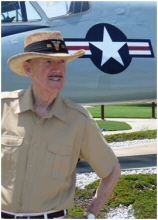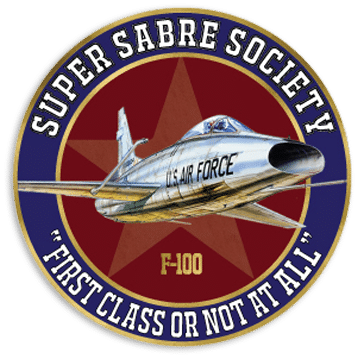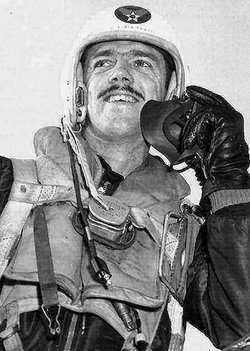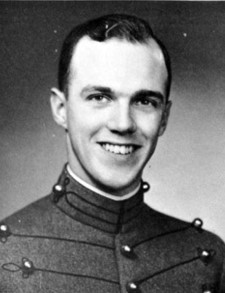“In August 1967, Major DeArmond entered the Industrial College at Fort McNair, Washington DC, while also studying for and receiving an M.B.A. from George Washington University at night. He is an honored graduate of Squadron Officer’s School 91954), the Air Command and Staff College (1986), and the Industrial College (1968).
Following the Industrial College, Lt. Colonel DeArmond reported to Luke Air Force base in Phoenix, Arizona for transition training in the F-100 D. In 1968, he reported to the 31st TAC Fighter Wing at Tuy Hoa Air Base, Vietnam. There he served as Commander of the 355th Tactical Fighter Squadron, and later as Assistant Deputy Commander for Operations. He flew 222 combat missions in Vietnam, and received a below-the-zone promotion to Colonel.
In 1970, Colonel DeArmond reported to the 36th TAC Fighter Wing at Bitburg, Germany, as Deputy Commander for Operations. In 1971, he reported to the 52nd TAC Fighter Wing at Spangdahlem Air Base as Vice Commander. In 1972, he moved to Lindsey Station, Germany as Director of Safety for U.S. Air Forces in Europe. In 1973, he became Commander of the 50th TAC Fighter Wing at Hahn Air Base, Germany. In 1974, he received promotion to Brigadier General.”(1)
Source: (1) https://www.fairfaxmemorialfuneralhome.com/obituaries/Michael-Edward-DeArmond?obId=2416843
Michael E. DeArmond, BGen USAF, Ret., “Headed West” on May 18, 2012.
 General DeArmond was born on June 12, 1928, at Fort Sam Houston, Texas where his father was stationed as a Lieutenant in the Army Signal Corps. His father transferred to the Air Corps and so he grew up on various Air Corps posts in the U.S. and Panama.
General DeArmond was born on June 12, 1928, at Fort Sam Houston, Texas where his father was stationed as a Lieutenant in the Army Signal Corps. His father transferred to the Air Corps and so he grew up on various Air Corps posts in the U.S. and Panama.
He graduated Cum Laude in 1946 from the Mercersburg Academy in Mercersburg, Pennsylvania, where he captained the track team. In 1950, he graduated from West Point, where he participated in varsity track, swimming, and soccer. He was a member of the 1947 West Point mile relay team that set the Academy and NCAA record and was selected as a member of the 1950 All American Swimming team, in the 400 yard free style.
DeArmond received a commission into the U.S. Air Force upon graduating from West Point, and received his pilot’s wings at Williams Air Force Base in Arizona in August 1951. Following combat crew training, he reported to the an F-80 wing in Korea, only to be immediately re-assigned to the 4th Fighter Group at Kimpo, Korea on Christmas Day 1951 as an F-86 pilot. After minimal training in the new aircraft, 1st Lieutenant DeArmond was on his 46th combat mission on 21 April 1952, when he became involved in a dog fight with multiple MIG-15s. His F-86 was hit by enemy fire at 25, 000 feet while deep into MIG Alley. Lt. DeArmond’s aircraft exploded into two halves, and he fell to 18, 000 feet before regaining sufficient consciousness to kick free of his seat, and deploy his parachute.
Following his capture, he spent seventeen months in solitary confinement as a prisoner of war in a Chinese P.O.W. camp. He was carried as MIA (Missing in Action) with no communications with other POWs, or with his family. Lt. DeArmond nearly died of dysentery in the summer of 1952. A year later, he was recaptured following two escape attempts. Lt. DeArmond was repatriated on September 3, 1953, and later flown to Tokyo Army Hospital before being re-united with his family.
On return to the States, Lt. DeArmond was assigned to the 95th Interceptor squadron at Andrews Air Force Base, Maryland, where he served from December 1953 to February 1956. During this period, he attended Squadron Officer School at Maxwell Air Force Base, Alabama. Following this, he was assigned as chief of intramural athletics at the Air Force Academy for a year. In 1957, he was transferred to Vance Air Force Base to train student pilots. In 1961, he was assigned overseas to Laon Air Base, France in a Tactical Reconnaisance Wing. In 1964, he reported to the Studies and Analysis Directorate in the Pentagon.
In August 1967, Major DeArmond entered the Industrial College at Fort McNair, Washington DC, while also studying for and receiving an M.B.A. from George Washington University at night. He is an honored graduate of Squadron Officer’s School 91954), the Air Command and Staff College (1986), and the Industrial College (1968).
Following the Industrial College, Lt. Colonel DeArmond reported to Luke Air Force base in Phoenix, Arizona for transition training in the F-100 D. In 1968, he reported to the 31st TAC Fighter Wing at Tuy Hoa Air Base, Vietnam. There he served as Commander of the 355th Tactical Fighter Squadron, and later as Assistant Deputy Commander for Operations. He flew 222 combat missions in Vietnam, and received a below-the-zone promotion to Colonel.
In 1970, Colonel DeArmond reported to the 36th TAC Fighter Wing at Bitburg, Germany, as Deputy Commander for Operations. In 1971, he reported to the 52nd TAC Fighter Wing at Spangdahlem Air Base as Vice Commander. In 1972, he moved to Lindsey Station, Germany as Director of Safety for U.S. Air Forces in Europe. In 1973, he became Commander of the 50th TAC Fighter Wing at Hahn Air Base, Germany. In 1974, he received promotion to Brigadier General.
In 1974, General DeArmond assumed Command of the Defense Supply Agency, DCASR Los Angeles. He was responsible for government procurement activity west of the Mississippi. There he supervised 3, 300 civil servants; 50 military officers; 126, 000 contracts; and payment to industries of $11 million dollars per day.
General DeArmond’s awards include the Distinguished Service Medal, the Legion of Merit, the Distinguished Flying Cross, the Air Medal with 13 Oak Leaf Clusters, the Air Force Commendation Medal, the Air Force Outstanding Unit Award Ribbon with Oak Leaf Clusters, the Prisoner of War Medal, the Republic of Korea presidential unit Citation, and the Republic of Vietnam Gallantry Cross with Palm.
General DeArmond was a Command Pilot with 268 combat missions and 4, 500 flying hours. He has flown the Lockheed F-80 Shooting Star, the T-33 T-Bird, the T-39 Sabreliner, the F-86 Sabre (A, E, and D’s), the North AmericanF-100 D Super Sabre, the RF-101 Voodoo, and the McDonnel Douglas F-4 Phantom.
General DeArmond retired from the Air Force after 27 years of service. Following retirement, General DeArmond went on to become President and Vice Chairman of Intertek Enterprises. General DeArmond was instrumental in growing the company from an $84K to a $26M per year business. After his second retiremen, General DeArmond moved to Clifton, Virginia where cared for five acres, three paddocks, and too many dogs and cats. General DeArmond worked for years on a biography project of all his West Point classmates who ended up in the Air Force. In his free time, he enjoyed travel, tennis, reading, keeping up with the Redskins, and keeping Marie Koneczny, his fiancé, happy.
General DeArmond’s marriage to the former Patricia Anne Buster ended in divorce after 27 years, and he raised his five daughters as a single parent. He is survived by all five of his daughters: Anna Boykin, Theresa Wittenschlaeger, Patricia DeSantis, Mary Sieve, and Catherine Sodergren, and by six grandchildren: Jeffery and Margaret Boykin, Penelope DeSantis, and Lucas, Kendall, and Madelyn Sodergren. General DeArmond also leaves behind his brother Robert DeArmond, and niece Renee DeArmond and nephew Chris DeArmond.
To send flowers to the family of Michael, please visit our floral store.












